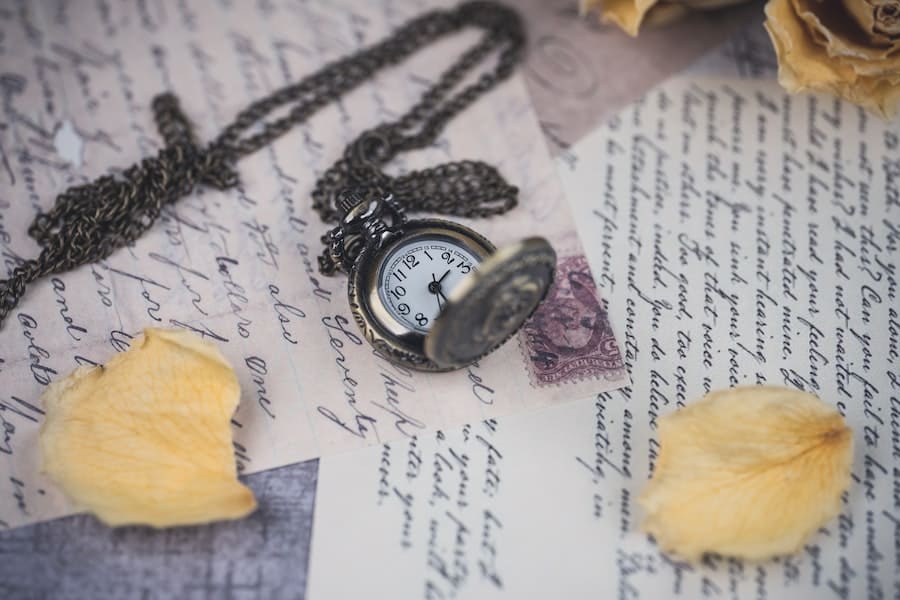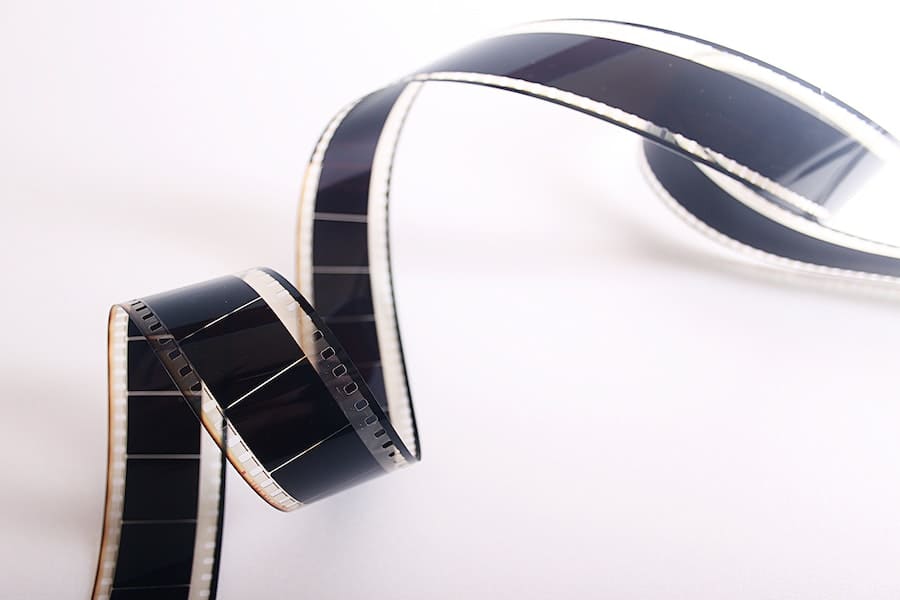Any writer can get up to speed with this literary device by examining a few anachronism examples — we promise!
But even though anachronisms aren’t complicated, there are some questions that need answers.
Like:
- Why would a writer use anachronisms?
- What are the different types of anachronisms?
- Are anachronisms different between film and literature?
So, we’ll cover this and more. Our post will offer up six examples to help you understand every angle of the ageless anachronism.
Let’s jump in!

What is Anachronism?
Anachronisms occur when something appears in a time period that it doesn’t belong in.
In Greek, ‘ana’ means ‘against’ and ‘chronos’ means ‘time.’ So anachronisms are literally against (or contrary to) time.
So what type of ‘something’ can make up an anachronism?
Well, almost anything.
Anachronisms can include anything from technology to fashion and more — spanning art, literature, and culture.
But for this post we’ll focus, primarily on their use as narrative or literary device.
Furthermore, an accidental or unintentional anachronism is common.
But when it happens, writers risk yanking the observer right out of the story.
(Think of the Starbucks cup left out in Game of Thrones.)
Intentional anachronisms, however, are often used as an effective literary device.
Why Use Anachronism?
Here are some of the most common reasons to use a literary anachronism…
To add humor: Anachronisms can deliver a surprise or a sarcastic scenario.
The Genie in Aladdin did this with his Jack Nicholson impersonation. Since Alladin took place in ancient Persia, well before the actor’s time period, the scenario is anachronistic and used for comedic effect.
To make a statement: Anachronisms can be attention grabbing.
Steampunk, for example, is known for its edgy use of anachronism. Steam powered engines with heat seeking missiles aren’t exactly an accurate combination chronologically, but they sure do make a statement.
To make the story more relatable: Modern language, fashion, or customs are often woven into timepieces in order to make them more relatable.
This happened with the use of modern-day language in Rosaline, a retelling of Shakespeare’s Romeo and Juliet from the perspective of Juliet’s sister.
The 3 Types of Anachronism You Should Know About

Anachronism’s three main variations all appear “against time,” but in slightly different ways.
Behavioral or Cultural Anachronism
Outdated cultural customs or behavior can be labeled anachronistic.
For instance, Agatha Christie’s The Mousetrap, could be considered culturally anachronistic.
Although scheduled to come to Broadway in 2023, the murder mystery is so old it began in 1947 as a radio program. Compared to its younger competition — Hamilton, Wicked, The Book of Mormon — you could argue it’s outdated.
Also, behaviorally anachronistic examples include someone choosing to be old-fashioned. For instance, dressing in outdated clothing, using ancient technology or even forsaking modern amenities.
Parachronism
Sometimes the ‘something’ that appears against time is unintentionally too late.
The film Night at the Museum provides multiple examples because the non-living museum inhabitants that come to life at night are all from the past.
Attila the Hun, Theodore Roosevelt, and many more suddenly find themselves in 2006.
However, the characters aren’t choosing to act like they’re from a different time frame (that would be behavioral anachronism). Instead, they are from a different time frame, and they’re just being themselves:
Attilla is still conquering, the cowboys are still fighting the Indians, and so on. What they all have in common is that they all appear too late.
Prochronism
Other times the ‘something’ that appears against time is too early, and literally impossible.
Mel Gibson’s Braveheart, for instance, portrayed the use of kilts in the 13th century. Except this was impossible because kilts weren’t used until the end of the 16th century.
Examples like this are common, and you might be surprised how often they show up.
3 Examples of Anachronism From Literature

The following examples highlight the vast creative license writers have when using a literary anachronism, as well as the powerful effect that can be achieved.
1. Don Quixote
The knight-errant Don Quixote, in Miguel de Cervantes’s novel, is a behavioral/cultural anachronism used for comedic effect.
This is because by the time the book was published, in 1605, chivalric knights had become a thing of the past.
The story then follows Alonso Quijano as he delusionally came to the conclusion that he was knight-errant Don Quixote. The knight-errant was an armor-clad wandering do-gooder who’s only complete with his squire, Sancho Panza.
Adventures ensue. Dragons are slain.
Except, not really.
The dragons Don Quixote fought were nothing but windmills.
Today, this would be like a fully suited cowboy clopping down Time Square on his trusty steed looking to right wrongs, six-shooters and all.
But as far as a literary device, Cervantes’s use of behavioral and cultural anachronism worked beautifully — Don Quixote is considered one of the best works of fiction ever.
2. Julius Caesar
In The Tragedy of Julius Caesar, William Shakespeare’s iconic play, there are several anachronism examples.
For some background, the story is a dramatic telling of Julius Caesar’s betrayal by those close to him.
Of note, at least two Elizabethan-era pieces show up in the play. One is the mention of a doublet, which is a piece of fashion found late in medieval times.
The other is the mention of a clock hand striking three, an obvious piece of technology that didn’t exist in ancient Rome.
This one gets interesting…
We don’t know if Shakespeare used these by accident or on purpose for artistic effect.
Although it’s likely the latter since one of the reasons to use intentional anachronism is to make a story more relatable to a modern audience.
You could argue not only did Shakespeare use them on purpose, but it also benefited those in the audience when the play was released.
3. A Connecticut Yankee in King Arthur’s Court
This curious tale by Mark Twain imagines what it would be like if an engineer from the 19th century woke up in King Arthur’s 6th century English kingdom.
After Hank Morgan, the engineer, suffers a blow to the head, he wakes up over a millenia earlier. The scenario is obviously anachronistic, but the peculiar part is in the other odd forms of anachronism.
Sir Lancelot, at one point, leads a group of knights on bicycles, and at the end, a gunfight pursues.
Nothing if not an allegorical tale, Twain pushes the limit of how much literary anachronism readers could stomach.
But as to whether the general trope of time travel and anachronisms go, you only need to reference the vast amount of modern stories and movies that use a similar plot:
- Bugs Bunny special, “A Connecticut Rabbit in King Arthur’s Court” (1979)
- Walt Disney studios, “A Kid in King Arthur’s Court” (1995)
- Terry Pratchett’s, “Once and Future” (1995)
- Walt Disney studios, “A Knight in Camelot” (1998)
Even the prominent Soviet sci-fi writers the Strugatsky brothers have been influenced by this story. Take a look at their books “Monday Begins on Saturday” and “Hard to Be a God.”
3 Examples of Anachronism From Film

Anachronisms in film are almost the same as in literature, except that you can see and hear them. It opens a whole new way to make a statement, add humor, or make the story more relatable.
1. Romeo + Juliet
Romeo + Juliet, the modern 1996 retelling of William Shakespeare’s classic, has a twist because it uses anachronistic language.
All of the dialogue is in Elizabethan English, even though the story takes place in modern “Verona Beach.” This mixture of a modern day setting contrasted with the old-fashioned speech is the inverse of the earlier Rosaline example, and makes for a bold statement.
When was the last time you noticed someone speaking in full Elizabethan?
Weird, right?
As to whether this use of anachronism benefitted or hindered the story, the reviews are mixed.
The mixed responses to Romeo + Juliet highlight the challenge of using anachronism creatively. Meshing the old and new will often strike a cord.
But what cord?
For Roger Ebert, well…
“The desperation with which it tries to ‘update’ the play and make it ‘relevant’ is greatly depressing.”
Yet, DeCaprio and Danes won several accolades and the film is still used today by English teachers to introduce their students to Elizabethan English.
2. Robin Hood: Men in Tights
Robin Hood: Men in Tights, the 1993 film, used anachronism liberally to retell the story of Robin Hood as a modern comedy.
The film references everything from modern technology to literature and separates the story from the comedic material by 800 years.
In one scene a jackhammer is used in an attempt by the evil Sheriff of Nottingham to get through Maid Marian’s “Everlast” branded chastity belt.
In another scene, Dave Chappelle’s character Ahchoo, asks for a time out before a fight in order to lean down and air up his pumps.
(For those of you who may not know, these were basketball sneakers that had pumps on the tongue to tighten the shoe around the wearer’s foot.)
Since the anachronisms were used completely on purpose for humor, they served to benefit the story.
3. Derry Girls
The British TV show Derry Girls had several anachronisms in their soundtrack.
The show followed a group of kids during the Northern Ireland conflict in the mid-’90s until the Good Friday referendum of 1988.
And the soundtrack was epically ‘90s — with artists like The Cranberries, Ace of Base, and Salt-N-Pepa — except when it wasn’t.
Devil’s Dance Floor by Flogging Molly was one track the series played, except the song wasn’t released until 2000.
Likewise, I’m Shipping Up to Boston by Dropkick Murphys wasn’t released until 2005!
Did it hinder the story?
Well, it sure could to anyone who remembers the time period.
But anachronistic soundtracks, it turns out, are extremely common.
Some are used for artistic sense, think of the modern hip-hop in Tarantino’s Django.
Or Jojo Rabbit taking place in Nazi Germany but playing ‘60s music from Roy Orbison.
Anachronism Examples To The Rescue

Anachronisms aren’t difficult to grasp.
But in order to use them creatively and effectively, writers need to reference the many examples at their disposal.
Who would’ve guessed the first modern novel used anachronism as a major literary device?
Or that anachronisms are a major factor in comedic storytelling?
Or how many popular stories are based on anachronisms?
OK, OK, you get the point.
But the exciting part is now you have access to the very same tools!
So, pick out your favorite anachronism, get creative, and get writing.
The post 6+ Anachronism Examples That’ll Get Any Writer Up to Speed appeared first on Smart Blogger.

No comments:
Post a Comment